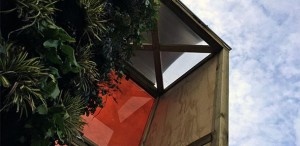
By combining green wall technology and solar panels, researchers have been able to generate renewable energy during both night and day.
Image: University of Cambridge
Researchers from Cambridge University have developed what is being considered “the greenest bus shelter” by combining solar power and plant power.
The scope of this project is much more vast than simply powering a bus shelter. Researchers are looking at this development as a possible answer to affordable power generation solutions for developing countries.
“To address the world’s energy needs, we need a portfolio of many different technologies, and it’s even better if these technologies work in synergy,” said Dr. Paolo Bombelli of Cambridge University’s Department of Biochemistry.
The bus shelter has the potential to power itself during both night and day times by harvesting the natural electron by-product of photosynthesis and metabolic activity, thus creating electrical current.
This from Cambridge University:
The thin-film solar panels turn light into electricity by using mainly the blue and green radiation of the solar spectrum. Plants grow behind the solar glass, ‘sharing the light’ by utilising the red spectrum radiation needed for photosynthesis, while avoiding the scorching effect of UV light. The plants generate electrical currents as a consequence of photosynthesis and metabolic activity during the day and night.
“This prototype is intended to inspire the imagination, and encourage people to consider what could be achieved with these pioneering technologies,” said Margherita Cesca, the hub’s designer.
To learn more about the future of renewable energy sources, make sure to attend the 227th ECS Meeting this May in Chicago!
And don’t miss the ECS Lecture featuring John A. Turner of the National Renewable Energy Laboratory!


